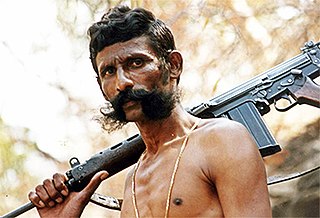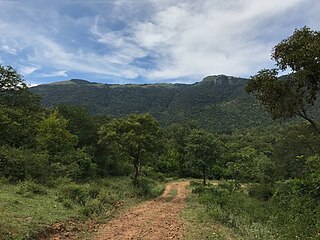Related Research Articles

Chamarajanagar or Chamarajanagara is the southernmost district in the state of Karnataka, India. It was carved out of the original larger Mysore District in 1998. Chamarajanagar town is the headquarters of this district.

Koose Munusamy Veerappan(Tamil-வீரப்பன்) was an Indian poacher, smuggler, domestic terrorist and bandit who was active for 36 years, and kidnapped major politicians for ransom. He was charged with sandalwood smuggling and poaching of elephants in the scrub lands and forests in the states of Tamil Nadu, Karnataka and Kerala. He was wanted for killing approximately 184 people, about half of whom were police officers and forest officials. He was also responsible for poaching approximately 500 of the 2000 elephants killed in the peninsular region where he was active and for smuggling ivory worth US$2.6 million and about 65 tons of sandalwood worth approximately US$22 million.

Sir Dietrich Brandis was a German-British botanist and forestry academic and administrator, who worked with the British Imperial Forestry Service in colonial India for nearly 30 years. He joined the British civil service in Burma in 1856, shortly afterwards became head of the British forestry administration in all of Burma, and served as Inspector General of Forests in India from 1864 to 1883. He returned to Europe in 1883, dividing his time between Bonn and Greater London. In retirement he dedicated himself to scholarly work, resulting in the book Indian Trees (1906), his magnum opus. Brandis is considered the father of tropical forestry and has also been described as the father of scientific forestry. In addition to his work in India, he also had a significant influence on forest management in the United States.

The Biligirirangana Hills or Biligirirangan Hills is a hill range situated in Chamarajanagar District in south-western Karnataka, at its border with Tamil Nadu in South India. The area is called Biligiri Ranganatha Swamy Temple Wildlife Sanctuary or simply BRT Wildlife Sanctuary. It is a protected reserve under the Wildlife Protection Act of 1972. Being close to the Eastern Ghats as well as the Western Ghats, the sanctuary has floral and faunal associations with both regions. The site was declared a tiger reserve in January 2011 by the Government of Karnataka, a few months after approval from India's National Tiger Conservation Authority.

The Indian Forest Service (IFS) is the premier forest service of India. It was constituted in the year 1966 under the All India Services Act, 1951.

Male Mahadeshwara Betta is a pilgrim town located in the Hanur taluk of Chamarajanagar district of southern Karnataka. It is situated at about 150 km from Mysuru and about 210 km from Bengaluru. The ancient and sacred temple of Sri Male Mahadeshwara is a pilgrim centre where Mahadeshwara lived, practiced medicine as Sidda, taught ahimsa to people in and around the seven hills. It draws lakhs of pilgrims from the states of Karnataka and Tamil Nadu. The area of the present temple surroundings is 155.57 acres (0.6296 km2). In addition, the temple has lands at Talabetta, Haleyuru and Indiganatha villages. Amidst dense forest, the temple attracts not only the pilgrims but also nature lovers. The height of the hill is about 3000 feet above sea level.
Alexander Gibson (1800–1867) was a Scottish surgeon and botanist who worked in India. He was born in Kincardineshire and studied at Edinburgh. He went to India as a surgeon in the Honourable East India Company. He became a superintendent of the Dapuri botanical gardens (1838-47) under the erstwhile Bombay Presidency.He was appointed as the first Conservator of Forests of India on 22 March 1847. He published several works on botany and reports on forestry in India. He laid a foundation stone of Indian forestry and made a memorable contribution.

Gandhada Gudi is a 1973 Indian Kannada-language action drama film directed by Vijay and produced by M. P. Shankar. Rajkumar in his 150th film portrays an honest forest officer Kumar while Vishnuvardhan plays the antagonist, Anand, though his character is redeemed at the end of the film. Kalpana, M. P. Shankar, Narasimharaju and Balakrishna performed other important roles.

Malli Amman Durgham - A quiet settlement in Eastern Ghats, amidst dense forests at the top of a mountain at Kadambur Forest Division, Sathyamangalam, Erode District, Tamil Nadu, India. Malli Amman Durgham

The Tamil Nadu Forest Department, formerly the Madras Forest Department, is a government department responsible for managing all the protected areas and forests plus environmental and wildlife related issues of Tamil Nadu state in South India. The objective of the Tamil Nadu Forest Department is to conserve biodiversity and eco-systems of forests and wilderness areas to ensure water security and food security of the state.

Colonel Vasanth Venugopal, AC was an Indian Army officer. He was the commanding officer of the 9th battalion, Maratha Light Infantry. On 31 July 2007, he was Attained veergathi in action while preventing heavily armed infiltrators from crossing the India-Pakistan border at Uri, Jammu and Kashmir. As a result he was posthumously awarded the Ashoka Chakra, India's highest military decoration for peacetime gallantry.
The Vachathi case involved a mass crime that occurred on 20 June 1992 in the village of Vachathi, in Dharmapuri district, Tamil Nadu. A team of 155 forest personnel, 108 policemen and six revenue officials entered the Tribal-dominated Vachathi village, searching for smuggled sandalwood and to gather information about Veerappan. Under the pretext of conducting a search, the team ransacked the villagers' property, destroyed their houses, killed their cattle, assaulted around 100 villagers, and raped 18 women.
Kannada film actor Rajkumar was abducted by Veerappan on July 30, 2000, during the course of an armed attack on a farmhouse belonging to the actor in Gajanur, Karnataka, India. Rajkumar was released by Veerappan on November 15, 2000, after spending 108 days in his custody. The kidnapping resulted in further deterioration of already strained relations between the Indian states of Tamil Nadu and Karnataka, creating a tense situation in the two states.
Gopinatham is a rural village located in Chamarajanagar district, Karnataka, India, in the border area of Tamil Nadu. It is the birthplace of Veerappan. The village is 144 kilometres (89 mi) from the district centre at Chamarajanagar among thick scrub forest and mountainous terrain.

The Palar Blast was a landmine attack on 9 April 1993 in Karnataka, India. The attack, organized by the forest brigand Veerappan, killed 22 people, making it the deadliest explosive attack in Karnataka during the 20th century.

Vinod Kumar Choubey, KC was an Indian Police Service officer who was killed by Maoist Naxalites during the July 2009 Rajnandgaon ambush. He is the first Indian Police Service officer in the state of Chhattisgarh to have died due to Naxal violence. Choubey was posthumously awarded the peacetime gallantry award "Kirti Chakra" by then President of India Pratibha Devi Singh Patil.

Operation Cocoon was an operation launched by the Special Task Force of Tamil Nadu Police to capture the forest brigand Veerappan and his associates, who were dominant in Sathyamangalam Forest in the South Indian states of Tamil Nadu, Karnataka and Kerala. The operation was headed by K. Vijay Kumar, and N. K. Senthamarai Kannan.

Killing Veerappan is a 2016 Indian Kannada-language biographical crime film directed by Ram Gopal Varma, who co-wrote the film with K. Balaji. The film is based on the events leading to Operation Cocoon to capture or kill Indian bandit Veerappan. Featuring Shiva Rajkumar in the central role touted to be based on N. K. Senthamarai Kannan, the then Superintendent of police, with the Indian Special Task Force, and the spy who masterminded Operation Cocoon.

Veerappan is a 2016 Indian Hindi-language biographical action crime film written and directed by Ram Gopal Varma. The film is based on the real-life Indian bandit Veerappan and the events leading to Operation Cocoon, a mission to capture and kill him. The film is a remake of the Kannada film Killing Veerappan (2016) starring Shiva Rajkumar. The film stars Sandeep Bharadwaj, Sachiin J Joshi, Lisa Ray and Usha Jadhav.
H. Nagappa was a Janata Dal (United) political leader, two term member of the Karnataka Legislative Assembly and minister for agricultural marketing in the J. H. Patel cabinet.
References
- ↑ "rediff.com Special: How Veerappan murdered one of the best foresters in Karnataka". www.rediff.com. Archived from the original on 22 October 2018. Retrieved 29 September 2020.
- ↑ "A Tribute to a Martyr: P.Srinivas" (PDF). mcrhrdi.gov.in. Archived (PDF) from the original on 24 November 2019. Retrieved 29 September 2020.
- ↑ "Memorial Lecture of P. Srinivas IFS" (PDF). Archived (PDF) from the original on 24 September 2015. Retrieved 18 February 2015.
- ↑ "Forest Martyrs" (PDF). Archived from the original (PDF) on 18 August 2013. Retrieved 18 February 2015.
- 1 2 "P. Srinivas: Slain by Deceit, This Brave IFS Battled Veerappan & Uplifted Villagers". 20 November 2019. Archived from the original on 21 November 2019. Retrieved 29 September 2020.
- ↑ "rediff.com Special: How Veerappan murdered one of the best foresters in Karnataka". in.rediff.com. Archived from the original on 18 February 2015. Retrieved 18 February 2015.
- ↑ https://www.etvbharat.com/amp/english/bharat/veerappans-village-worships-andhra-born-ifs-srinivas-for-changing-their-lives/na20220908153809440440524
- ↑ "The man who caught Veerappan alive". www.rediff.com. Archived from the original on 21 October 2018. Retrieved 29 September 2020.